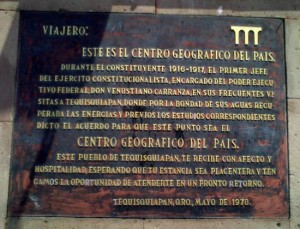An interesting historical example of central place theory is described in Ancient Mesoamerica: a comparison of change in three regions. Central place theory suggests that places of similar size (or occupying a similar level in a region’s urban hierarchy) should form a distinctive spatial pattern. They will be roughly equidistant from one another.The pattern is conceptualized as a series of hexagons, with a settlement at each apex. Such a pattern permits an equidistant spacing in all directions, and has no “gaps” where any territory falls outside (beyond) the “sphere of influence” of one or other of the settlements.
Several archaeologists interested in the Maya have suggested that central place theory offers a way to help explain the pattern of Maya sites in the Yucatán Peninsula and further south into Guatemala. They have postulated that Maya settlements may indeed form a hierarchy in terms of size and importance, with a relatively small number of major regional centers overseeing a larger number of smaller centers. Furthermore, where such a pattern exists, it suggests a high degree of political organization.
This particular example comes from the south-east corner of Campeche, near the Guatemala border.
The major regional center in this case is Calakmul (a World Heritage site since 2002). Calakmul is surrounded by six smaller centers, which are close to equidistant from each other, as well as from Calakmul. In turn, Uxul has several smaller subordinate settlements around it.
In this example, the average distance between settlements is about 33 kilometers (20.5 miles), which is approximately one day’s walk and/or canoe trip in this region. So, an individual could leave somewhere like Altamira in the morning and reach Calakmul before nightfall, and vice versa.
Not all Maya archaeologists believe that central place theory is helpful in explaining the distribution of settlements in the region. Some argue that the daily travel distance is the key, and that patterns such as that found around Calakmul are as much due to coincidence as any kind of overriding pattern.
The original theory, as proposed by German geographer Walter Christaller in 1933, was based on various assumptions. In particular, the region was assumed to be an unbounded isotropic (flat) plain, homogeneous in all significant physical aspects (soil, access to water, vegetation, etc), and population was assumed to be evenly distributed. The Yucatán Peninsula is certainly an area of low relief, but access to water and vegetation vary significantly from one area to another, so Christaller’s basic assumptions are not met in the region. On the other hand, there is no denying that a highly structured society might decide (even without having studied AP Human Geography or A-level Geography) that regularly-spaced settlements are an ideal solution to issues of transportation, administration and control.
For a more academic discussion of the merits of central place theory in Maya research, see Brown and Witschey’s The Geographic Analysis of Ancient Maya Settlement and Polity [pdf file], a paper presented in 2001 at the Electronic Cultural Atlas Initiative, City University, Hong Kong.
Source:
Blanton, Richard E., Stephen A. Kowalewski, Gary Feinmann and Jill Appel. Ancient Mesoamerica: a comparison of change in three regions. Cambridge University Press, 1981.
Related posts:

